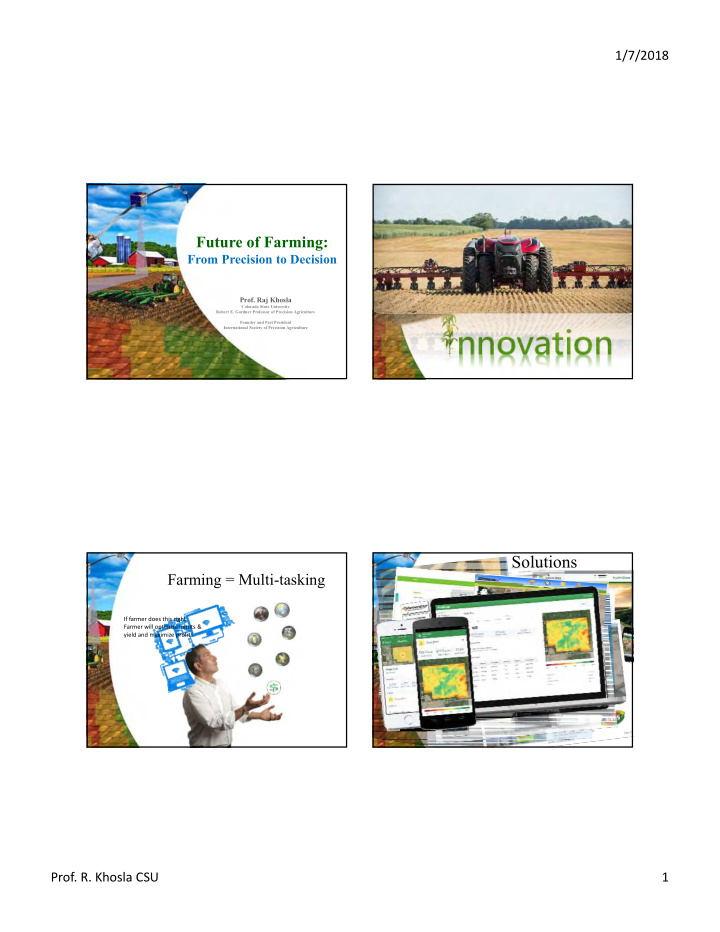



1/7/2018 Agriculture is changing Future of Farming: From Precision to Decision Prof. Raj Khosla Colorado State University Robert E. Gardner Professor of Precision Agriculture Founder and Past President nnovation International Society of Precision Agriculture Solutions Farming = Multi-tasking If farmer does this right Farmer will optimize inputs & yield and maximize profits Prof. R. Khosla CSU 1
1/7/2018 Quality Pollination Food safety Wind speed Fuel cost Input cost Market value GPS Humidity Investment Cold chain Air Precipitations Gender equity Fuel consumption Temperature Storage supply Speed Engine performance Education Solution to what? Crop ET Machine health indicator rket Safety Infestation level Plant population Labor Livestock Soil EC Genetics Bulk density NBI Climate Weather K content change P content LAI Diseases Yield Management zone Spatial Crop Canopy variability OM Management Temperature Tradition NDVI Yield potential Innovation Fertilizer Texture pH Water Soil water content Land Weed infestation Pest N content Soil Temperature Soil Manure Harves ting Ecology Weeds Machinery Succession Age Neighbors Crop Crop Soil Soil Water Water Technology Technology It will get complex… before it gets easy Data Data Weather Weather BIG DATA Prof. R. Khosla CSU 2
1/7/2018 Why do we need complex solutions? When was the first auto-pilot system invented? 2002 1998 1962 1938 How do you climb a mountain? How do you do precision agriculture? One step at a time…. 1908 One field, one farm at a time…. Why do we need complex solutions? Big Four Tractor… steering device consisted of a small pilot wheel 2008 1998 1968 1938 1908 which runs along in the furrow ahead of the engine and is connected with the front axle Prof. R. Khosla CSU 3
1/7/2018 Variability!! Variability!! Mercer and Hall (1911) Variation in crop yields in small plots in fields at Rothamsted Research, Harpenden, England. At the regional scale At the field scale At the farm scale Yield Map Mean: 182.5 bu/A <172.5 bu/A Pixels = Average? Spatial variations in soil often translate into variations in crop 24% +/- 10 bu/A from the mean +/- 2 bu/A from the mean ��� ����� � �% 8% Over-fertilized Only 36% >192.5 bu/A 40% Under-fertilized Prof. R. Khosla CSU 4
1/7/2018 Management Zones Farming the data… adding value “A sub-region of a field that expresses a • Precision farming is not only about farming homogeneous combination of yield limiting factors” the land… its also about Farming the data!! • Adding value…. foster adoption In Colorado, we developed four techniques of delineating management zones Management Zones… Management Zones… 2. Field topography 1. Bare soil imagery • Soil organic matter Elevation map • Moisture content and • Other stable soil properties (bulk density, texture, compaction, etc) Grain yields are correlated with topography Prof. R. Khosla CSU 5
1/7/2018 Delineating management zones… Management Zones… The three data layers Aerial Imagery Topography 3. Farmer’s experience Farmer’s experience are stacked as GIS layers to delineate the zone Low Productivity Traits such as dark color, low-lying (Zone 3) High topography, and historic high yields Productivity were designated as a zone of (Zone 1) potentially high productivity or high zone Medium Productivity (Zone 2) Management zones… Mean grain yield across MZs Precision Manure Management 12 16 20 • Suggestions from growers… Grain yield (Mg ha -1 ) 12 Grain yield (Mg ha -1 ) 9 Grain yield (Mg ha -1 ) 15 • Could we site‐specifically apply animal 8 6 10 b b b b ab a a manure to improve soil quality, productivity a a 4 3 5 of low management zones? 0 • Disposing manure is a significant challenge 0 0 Low Medium High Low Medium High Low Medium High Management zones Management zones Management zones • precision manure management sounded like an opportunity Up to 46% reduction in N loadings without impairing grain yields Source: Koch, Khosla, et al. 2004 Prof. R. Khosla CSU 6
1/7/2018 Growers typically apply 10 - 20t/ac of manure once every three years Nitrogen Mineralization Manure Rates % of Total N Uptake 60 250 % of Total N Uptake 60 Mineralization rate analysis - 60 tons/ac + & NO 3 was conducted in a laboratory at a constant temp. (60 o F) 200 30 tons/ac 40 Cumulative NH 4 40 mg/Kg 150 Rapid Uptake Begins 20 tons/ac 20 10 tons/ac 20 Manure applied 1 month 100 before planting. Thank you Average daily temp. 40 o F. 50 0 5 15 30 60 90 120 V2 V4 V9 V12 Growth Stage V6 VT V2 V4 V9 V12 Moshia, Matshwene, et al. “Precision Manure Growth Stage V6 VT Thank you Days Management on Site‐Specific Management 10 20 30 40 50 60 Zones: Nitrogen Mineralization.” Journal of Growing Days 10 20 30 40 50 60 Growing Days Plant Nutrition , vol. 39, no. 1, 2015, pp. 59– 70., doi:10.1080/01904167.2015.1009547. Raj.Khosla@Colostate.Edu Colorado State University Prof. R. Khosla CSU 7
Recommend
More recommend